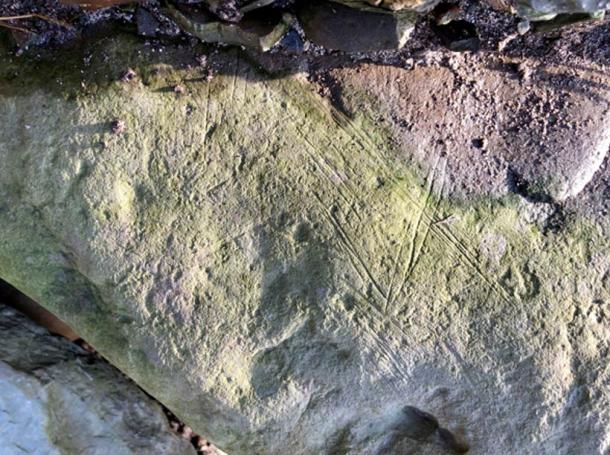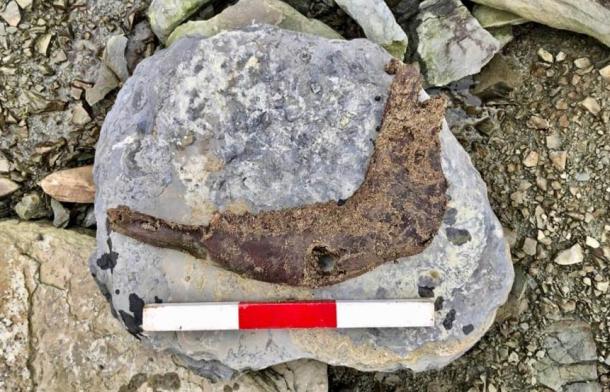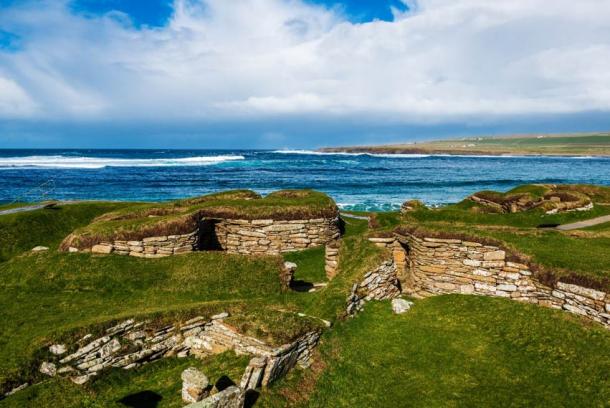Archaeologists in Orkney believe they “might” have discovered another 5,000-year-old Neolithic settlement in the Bay of Skaill, beside the world famous Skara Brae. Thought to date to around 3,000 BC, the newly discovered “suspected” Neolithic site was discovered in the far north of Scotland on Mainland Orkney. Costal erosion revealed ancient animal bones and what might be a carved stone, in ground dating back to 3,100 BC. And while Skara Brae is considered the best-preserved Neolithic settlement in Western Europe, this new Bay of Skaill site is being described as “on par with Skara Brae.”

One of the decorated faces of a large stone found in Structure Ten, Ness of Brodgar, in 2013, that has the same markings as the new stone found at the Bay of Skaill. (Hugo Anderson-Whymark / UHI Archaeology Institute )
Bay of Skaill Find “Might” Be Another Skara Brae
The new “possible” Neolithic site was discovered by Sigurd Towrie from the University of the Highlands and Islands after a wall was exposed by the eroding effects of tides and rain. According to an article in The Orcadian the researcher unearthed deer antlers, a boar tooth and a cattle jawbone.
Furthermore, the local newspaper reported that “a large decorated stone with a pair of incised triangles and a series of rectangular bands running across the surface” was found. And all of these discoveries were made in earth that previous environmental sampling “suggests” dates back around 5,000 years.
Towrie discovered what “might” be a carved stone after noticing animal remains falling from an eroding section of shoreline in the Bay of Skaill. Dr Antonia Thomas, the Archaeology Institute’s rock art specialist, said the large, decorated stone was “potentially a carved stone” similar to those discovered at Skara Brae. Furthermore, based on the scale of the eroded section Towrie said “we may well be looking at a Neolithic/ Bronze Age site on a par with Skara Brae.”

The cow jawbone recovered from the eroding shoreline section where the incised stone was found in the Bay of Skaill. ( Sigurd Towrie / UHI Archaeology Institute )
A “Potentially” Important Site, Desperate For Excavation
Skara Brae was discovered in the 1850s after a storm ripped off the caps of two mounds in the Bay of Skaill but the site went unexcavated until the 1920s and 30s. This ancient settlement site has provided archaeologists with thousands of artifacts, each of which offered a unique insight into how early hunting and fishing cultures transitioned into agrarian lifestyles around 5000 BC.
Skara Brae is considered the best-preserved prehistoric settlement in the British Isles, and it also represents the largest complete Neolithic village in Europe, and this is why it is a protected UNESCO World Heritage Site . You can read all about the discovery of Skara Brae in my 2016 book A Twist In Time , which analyses the craft tools discovered at the site.
Skara Brae was occupied from about 3180 BC until about 2500 BC at which time the climate changed rapidly, and around 4,500 years ago the inhabitants abandoned the village. The new site was discovered after a stone wall was identified running out from an eroding section on to the beach.
According to an article in The Daily Mail , that wall is “disappearing at an alarming rate” due to coastal erosion . Towrie said the UHI Archaeology Institute is carefully monitoring the erosion at the Bay of Skaill. And while immediate excavation is required, with the current coronavirus lockdowns this won’t happen any time soon.

The Skara Brae site in the Orkney Islands is just 200 meters (200 yards) away from the newly discovered site on the Bay of Skaill. ( XtravaganT / Adobe Stock)
Just Another Brick In The Wall
Putting this discovery of what “might” be a new Skara Brae into context, though this one made the headlines, in 2019 a different researcher discovered another wall eroding from the dunes beside Skara Brae. And while the site mentioned in this article is over half-a-mile north of Skara Brae, the “possible” site discovered in 2019 is only 200 meters along the beach from the UNESCO site.
That guy who discovered the possible new site in 2019 was myself, while I was researching for a new book, and in this YouTube video I published in November 2019 you can watch me on Skaill Beach pointing out a line of shells which “might” be a Neolithic shell midden .
Furthermore, like the recent discovery, I too discovered what appeared to be the remains of a substantial wall in the shadow of Skara Brae. Only time will tell, however, if these new sites are indeed rivals to Skara Brae, or merely annexes of the main fishing village.
Top image: A closeup of the incisions on the Bay of Skaill stone recently found just next to Skara Brae. ( Sigurd Towrie / UHI Archaeology Institute )
By Ashley Cowie
Related posts:
Views: 0
 RSS Feed
RSS Feed















 February 13th, 2021
February 13th, 2021  Awake Goy
Awake Goy  Posted in
Posted in  Tags:
Tags: 
















